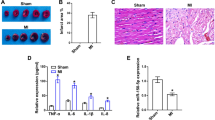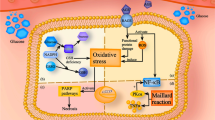Abstract
Background
Diabetic nephropathy (DN) is the leading cause of end-stage renal disease (ESRD) worldwide. Emerging evidence suggests that long non-coding RNAs (lncRNAs) play crucial roles in DN pathogenesis.
Objective
The purpose of the present study was to explore the role and mechanism of lncRNA tetratricopeptide repeat domain 2B antisense RNA 1 (TTC28-AS1) in DN.
Methods
Cell viability and apoptosis were assessed by the Cell Counting-8 Kit (CCK-8) assay and flow cytometry, respectively. The levels of TTC28-AS1, miR-320a and CD2-associated protein (CD2AP) were determined by quantitative real-time polymerase chain reaction (qRT-PCR) or western blot. The levels of interleukin-6 (IL-6), tumor necrosis factor-α (TNF-α), and IL-8 were gauged by enzyme-linked immunosorbent assay (ELISA). Targeted relationship between miR-320a and TTC28-AS1 or CD2AP was evaluated by dual-luciferase reporter and RNA immunoprecipitation (RIP) assays.
Results
Our data indicated that high glucose (HG) induced HK-2 cell damage by the repression of cell viability and autophagy and the enhancement of cell apoptosis, fibrosis and pro-inflammatory cytokines production. TTC28-AS1 was down-regulated and miR-320a was up-regulated in HG-induced HK-2 cells. TTC28-AS1 overexpression or miR-320a knockdown alleviated HG-induced damage in HK-2 cells. MiR-320 was a molecular mediator of TTC28-AS1 in regulating HG-induced HK-2 cell damage. Moreover, TTC28-AS1 functioned as a post-transcriptional regulator of CD2AP expression by miR-320a. MiR-320a knockdown relieved HG-induced damage in HK-2 cells by up-regulating CD2AP.
Conclusions
Our findings suggest that TTC28-AS1 attenuates HG-induced damage in HK-2 cells at least partially by targeting the miR-320a/CD2AP axis, highlighting its role as a promising therapeutic approach for DN treatment.








Similar content being viewed by others
References
Bijkerk R, Duijs JM, Khairoun M, Ter Horst CJ, van der Pol P, Mallat MJ, Rotmans JI, de Vries AP, de Koning EJ, de Fijter JW et al (2015) Circulating microRNAs associate with diabetic nephropathy and systemic microvascular damage and normalize after simultaneous pancreas-kidney transplantation. Am J Transplant 15:1081–1090
Chen SJ, Lv LL, Liu BC, Tang RN (2020) Crosstalk between tubular epithelial cells and glomerular endothelial cells in diabetic kidney disease. Cell Prolif 53:e12763
Chen YQ, Wang XX, Yao XM, Zhang DL, Yang XF, Tian SF, Wang NS (2012) Abated microRNA-195 expression protected mesangial cells from apoptosis in early diabetic renal injury in mice. J Nephrol 25:566–576
Conserva F, Barozzino M, Pesce F, Divella C, Oranger A, Papale M, Sallustio F, Simone S, Laviola L, Giorgino F et al (2019) Urinary miRNA-27b-3p and miRNA-1228-3p correlate with the progression of Kidney Fibrosis in Diabetic Nephropathy. Sci Rep 9:11357
Czajka A, Malik AN (2016) Hyperglycemia induced damage to mitochondrial respiration in renal mesangial and tubular cells: Implications for diabetic nephropathy. Redox Biol 10:100–107
Ding Y, Choi ME (2015) Autophagy in diabetic nephropathy. J Endocrinol 224:R15–R30
Ge Y, Wang J, Wu D, Zhou Y, Qiu S, Chen J, Zhu X, Xiang X, Li H, Zhang D (2019) lncRNA NR_038323 Suppresses Renal Fibrosis in Diabetic Nephropathy by Targeting the miR-324-3p/DUSP1 Axis. Mol Ther Nucleic Acids 17:741–753
Gnudi L, Coward RJM, Long DA (2016) Diabetic Nephropathy: Perspective on Novel Molecular Mechanisms. Trends Endocrinol Metab 27:820–830
Guo J, Liu Z, Gong R (2019) Long noncoding RNA: an emerging player in diabetes and diabetic kidney disease. Clin Sci (Lond) 133:1321–1339
Ha TS, Hong EJ, Han GD (2015) Diabetic conditions downregulate the expression of CD2AP in podocytes via PI3-K/Akt signalling. Diabetes Metab Res Rev 31:50–60
He M, Wang J, Yin Z, Zhao Y, Hou H, Fan J, Li H, Wen Z, Tang J, Wang Y et al (2019) MiR-320a induces diabetic nephropathy via inhibiting MafB. Aging 11:3055–3079
Huang YF, Zhang Y, Liu CX, Huang J, Ding GH (2016) microRNA-125b contributes to high glucose-induced reactive oxygen species generation and apoptosis in HK-2 renal tubular epithelial cells by targeting angiotensin-converting enzyme 2. Eur Rev Med Pharmacol Sci 20:4055–4062
Hyvönen ME, Ihalmo P, Sandholm N, Stavarachi M, Forsblom C, McKnight AJ, Lajer M, Maestroni A, Lewis G, Tarnow L et al (2013) CD2AP is associated with end-stage renal disease in patients with type 1 diabetes. Acta Diabetol 50:887–897
Iwakawa HO, Tomari Y (2015) The Functions of MicroRNAs: mRNA Decay and Translational Repression. Trends Cell Biol 25:651–665
Kanasaki K, Taduri G, Koya D (2013) Diabetic nephropathy: the role of inflammation in fibroblast activation and kidney fibrosis. Front Endocrinol (Lausanne) 4:7
Khan NU, Lin J, Liu X, Li H, Lu W, Zhong Z, Zhang H, Waqas M, Shen L (2020) Insights into predicting diabetic nephropathy using urinary biomarkers. Biochim Biophys Acta Proteins Proteom 1868:140475
Kim H, Bae YU, Jeon JS, Noh H, Park HK, Byun DW, Han DC, Ryu S, Kwon SH (2019) The circulating exosomal microRNAs related to albuminuria in patients with diabetic nephropathy. J Transl Med 17:236
Kyung SY, Kim DY, Yoon JY, Son ES, Kim YJ, Park JW, Jeong SH (2018) Sulforaphane attenuates pulmonary fibrosis by inhibiting the epithelial-mesenchymal transition. BMC Pharmacol Toxicol 19:13
Lin Z, Li X, Zhan X, Sun L, Gao J, Cao Y, Qiu H (2017) Construction of competitive endogenous RNA network reveals regulatory role of long non-coding RNAs in type 2 diabetes mellitus. J Cell Mol Med 21:3204–3213
Ling HY, Ou HS, Feng SD, Zhang XY, Tuo QH, Chen LX, Zhu BY, Gao ZP, Tang CK, Yin WD et al (2009) CHANGES IN microRNA (miR) profile and effects of miR-320 in insulin-resistant 3T3-L1 adipocytes. Clin Exp Pharmacol Physiol 36:e32–e39
Loganathan TS, Sulaiman SA, Abdul Murad NA, Shah SA, Abdul Gafor AH, Jamal R, Abdullah N (2020) Interactions Among Non-Coding RNAs in Diabetic Nephropathy. Front Pharmacol 11:191
Lu TX, Rothenberg ME (2018) MicroRNA. J Allergy Clin Immunol 141:1202–1207
Lv L, Li D, Tian F, Li X, Jing Z, Yu X (2019) Silence of lncRNA GAS5 alleviates high glucose toxicity to human renal tubular epithelial HK-2 cells through regulation of miR-27a. Artif Cells Nanomed Biotechnol 47:2205–2212
Lv LL, Cao YH, Pan MM, Liu H, Tang RN, Ma KL, Chen PS, Liu BC (2014) CD2AP mRNA in urinary exosome as biomarker of kidney disease. Clin Chim Acta 428:26–31
Ming L, Ning J, Ge Y, Zhang Y, Ruan Z (2019) Excessive apoptosis of podocytes caused by dysregulation of microRNA-182-5p and CD2AP confers to an increased risk of diabetic nephropathy. J Cell Biochem 120:16516–16523
Mohamadi M, Ghaedi H, Kazerouni F, Erfanian Omidvar M, Kalbasi S, Shanaki M, Miraalamy G, Rahimipour A (2019) Deregulation of long noncoding RNA SNHG17 and TTC28-AS1 is associated with type 2 diabetes mellitus. Scand J Clin Lab Invest 79:519–523
Quinn JJ, Chang HY (2016) Unique features of long non-coding RNA biogenesis and function. Nat Rev Genet 17:47–62
Tanida I, Ueno T, Kominami E (2008) LC3 and Autophagy. Methods Mol Biol 445:77–88
Tay Y, Rinn J, Pandolfi PP (2014) The multilayered complexity of ceRNA crosstalk and competition. Nature 505:344–352
Wang XH, Qian RZ, Zhang W, Chen SF, Jin HM, Hu RM (2009) MicroRNA-320 expression in myocardial microvascular endothelial cells and its relationship with insulin-like growth factor-1 in type 2 diabetic rats. Clin Exp Pharmacol Physiol 36:181–188
Wang Y, Li Y, Yang Z, Wang Z, Chang J, Zhang T, Chi Y, Han N, Zhao K (2019) Pyridoxamine Treatment of HK-2 Human Proximal Tubular Epithelial Cells Reduces Oxidative Stress and the Inhibition of Autophagy Induced by High Glucose Levels. Med Sci Monit 25:1480–1488
Xu HD, Qin ZH (2019) Beclin 1, Bcl-2 and Autophagy. Adv Exp Med Biol 1206:109–126
Xue M, Li Y, Hu F, Jia YJ, Zheng ZJ, Wang L, Xue YM (2018) High glucose up-regulates microRNA-34a-5p to aggravate fibrosis by targeting SIRT1 in HK-2cells. Biochem Biophys Res Commun 498:38–44
Zhang X, Wang W, Zhu W, Dong J, Cheng Y, Yin Z, Shen F (2019) Mechanisms and Functions of Long Non-Coding RNAs at Multiple Regulatory Levels. Int J Mol Sci 20:5573
Zheng S, Powell DW, Zheng F, Kantharidis P, Gnudi L (2016) Diabetic Nephropathy: Proteinuria, Inflammation, and Fibrosis. J Diabetes Res 2016:5241549
Zhou L, Xu DY, Sha WG, Shen L, Lu GY (2018) Long non-coding RNA MALAT1 interacts with transcription factor Foxo1 to regulate SIRT1 transcription in high glucose-induced HK-2cells injury. Biochem Biophys Res Commun 503:849–855
Zhou L, Xu DY, Sha WG, Shen L, Lu GY, Yin X (2015) Long non-coding MIAT mediates high glucose-induced renal tubular epithelial injury. Biochem Biophys Res Commun 468:726–732
Acknowledgements
Not applicable.
Funding
This study was supported by Xiangyang Science and Technology Projects ([2012] NO.40).
Author information
Authors and Affiliations
Contributions
Conceptualization: JZ and JD. Acquisition of data: MY, FL and XZ. Writing and review of manuscript: All authors. Study supervision: HS. Manuscript approval: All authors.
Corresponding author
Ethics declarations
Conflict of interest
Ji Zhang, Juan Ding, Ming Yu, Fang Li, Xue Zhou and Hongxia Shuai declare that they have no conflict of interest.
Ethics approval
Not applicable.
Additional information
Publisher’s Note
Springer Nature remains neutral with regard to jurisdictional claims in published maps and institutional affiliations.
Supplementary Information
Below is the link to the electronic supplementary material.
Rights and permissions
About this article
Cite this article
Zhang, J., Ding, J., Yu, M. et al. Long non-coding RNA TTC28-AS1 attenuates high glucose-induced damage in HK-2 cells depending on the regulation of miR-320a/CD2AP axis. Genes Genom 43, 1471–1482 (2021). https://doi.org/10.1007/s13258-021-01167-z
Received:
Accepted:
Published:
Issue Date:
DOI: https://doi.org/10.1007/s13258-021-01167-z




